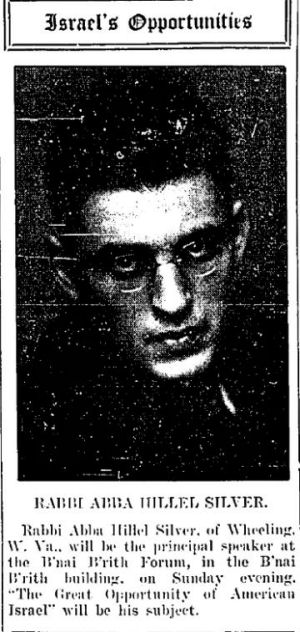|
"After studying
each man separately the process of elimination was started
until the list dwindled down to twenty, then to ten, then to
five or six. All these possibilities were then carefully
studied in their own pulpits, on the streets, in their homes
and from every other possible standpoint. Then the question
finally resolved itself to this: Does the Temple want a man
of mature years, who has already made a reputation, a man
who is brilliant and pleasing, who would be taken away from
an assured position, or does the Temple want a young man
of brilliant possibilities, who has only been in the pulpit
two years or so." (emphasis ours) |
Lowenstein says that the Board
unanimously preferred to select a young man. Perhaps they remembered how well a preference for youth had worked
before when their beloved Rabbi Gries, then 24 years old, was called
to the Temple.
See endnote about
Dr. Kaufmann Kohler.
By mid-February 1917, only ten
weeks before the Temple's annual meeting when the name of the new
rabbi should be announced, the list of candidates would have been
reduced to only a few names.
February 24, 1917
— Coming to Cleveland for the B'nai B'rith speech
Abba Hillel Silver was active in the Wheeling
lodge of
B'nai B'rith (Sons of the Covenant) and
would
give talks at lodges in other cities. (Tribute from I.O.B.B.)
Many of Cleveland's leading Jewish men, including Rabbis Gries and
Wolsey and Alfred Benesch, were active B'nai B'rith members. (The
Jewish Independent had said they would be delegates to the Ohio
B'nai B'rith convention that summer.)
The Friday February 23, 1917 edition
of Cleveland's weekly Jewish Independent displayed a picture
of Abba
Hillel Silver for the first time, announcing his talk at the B'nai
Brith Forum that Sunday evening.

The B'nai Brith Building was on
Euclid Avenue at East 71st Street. (Note: an earlier version of this
page incorrectly placed the event at a now lost building at 1624
East 55th Street. (2/2019)
Such a subject (Israel
would refer to the Jewish people, not to a state of Israel) would
let Abba Hillel Silver share his vision of progress and social
justice and inspire his audience with prophetic zeal. There are no
reports of this speech in the Cleveland newspapers, but it had an immediate result.
The trustees of the Temple who heard it (Lowenstein told Silver that
all of them had been there) knew
they had found their next rabbi.
See endnote about
who invited Silver to speak in
Cleveland?
March 1917
— Lowenstein
'closes the deal' in Wheeling
As Lowenstein said in the
announcement in the Jewish Independent, "The committee then narrowed the selection down to one
young man." That man was Abba Hillel Silver.
Lowenstein now needed to make a
trip to Wheeling to 'close the deal'. To do this in ample time for
the annual meeting near the end of April, the trip would have been
made in March or early April. After taking a train from Cleveland to
Wheeling he visited Moses Sonneborn, the president of Leshem
Shomayim. Lowenstein relates how he told about his mission to find a new rabbi
for the Temple and that Silver was their choice.
|
"... and added that the young rabbi
had not been approached and has no idea that he is wanted in
Cleveland. "If you say so," Mr. Lowenstein said to the
president, "I will take the next train back to Cleveland and
nobody will ever know what I came for or that I was here at
all." The president
[of Leshem Shomayim] was so surprised and delighted at the
manner in which Mr. Lowenstein put the proposition that he
said he would not stand in the young rabbi's light." |
The following evening
the Leshem Shomayim trustees met and agreed not to stand in Silver's
way.
The next morning President Lowenstein met
with the young rabbi and put the proposition to him. Silver had
rejected an offer from another large congregation the year before.
Further, in June 1916, at the end of his first year at Leshem
Shomayim, he had accepted a salary
increase and a two-year contract that would not end until June 1918.
|
"I cannot accept
it" was the rabbi's reply.
"Why not"
"Because the people here have been good to me. I love this
community and I will not leave here unless my congregation
tells me to go."
Then Mr.
Lowenstein told him of his talks with the Board and how they
did not like to see him go, but would not stand in his way,
and he finally gave his consent. The trustees [of the
Temple] had all heard him speak at the time he spoke in the
B'nai B'rith building, and he was their unanimous choice for
rabbi." |
Abba Hillel Silver's consent meant moving
from Wheeling, a city of about 40,000, to Cleveland - then the
nation's sixth largest city, to a congregation five times the size
of Leshem Shomayim and of national renown, and to a salary (see
note) of
$10,000, nearly four times what he was currently earning. Most important, as
Silver wrote in his letter of resignation,
he would be useful "in a larger field."
See endnote about
salaries.
April 20 —
Unofficial news of Silver's selection
On April 20, nine days before
the Temple annual meeting when the selection would be announced, the front
page of the Jewish Independent reported unofficially (but
confidently) that the decision to select Abba Hillel Silver had
been made soon
after February 24 B'nai B'rith speech. The story ends with
the question "Will Wheeling let him go?"

Jewish Independent April 20, 1917
Wheeling had already let him go.